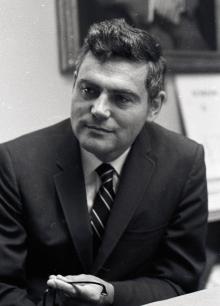- COVID-19 Project
- Home
- Archival Material
- College History Projects
- Subject-Based Digital Projects
- Carlisle Indian School Resources
- LGBT History Project
- Three Mile Island (TMI) Resources
- Civil War Resources
- James Buchanan Resources
- Slavery and Abolition in the U.S.
- Russian and Slavic Resources
- AIFS / AIFS Foundation Collection
- Books of Isaac Norris
- Writings by Dickinsonians
- Digital Images on Flickr
- Dickinson @ Internet Archive
Gerald Stanley Hawkins (1928-2003)

Gerald Hawkins was born on April 28, 1928 in eastern England in the Norfolk fishing town of Great Yarmouth. He attended the University of London, gaining a degree in Physics in 1949, before going on to Manchester University's famous Jodrell Bank radio telescope facility and earned his doctorate under the direction of Sir Bernard Lovell in 1952. For several years he worked on secret military missile technology for the Ferranti Brothers Company, but, in 1955, he emigrated to the United States where he had been named as director of the Harvard Radio Meteor Project. He took up the chair of Astronomy at Boston University in 1957 while also working as astronomer at the Smithsonian Astrophysical Laboratory.
During the 1960s, Hawkins became famous for his incisive ideas concerning the relationship between the construction of Stonehenge and the position of the sun and moon as they rose and set over a cycle of 18.6 years. With John B. White, he published his very popular Stonehenge Decoded in 1965 and he remained interested in this new field of archæastronomy including work in Peru and other sites. In 1969, he was appointed as Dean of the College at Dickinson under President Howard Rubendall. His eighteen months as Dean were not placid or happy ones since his style of leadership clashed with a faculty just becoming used to the measure of responsibility the Rubendall administration had afforded them. Professor Stanley Nodder of Greek, for example, selected as an associate dean before Hawkins' appointment, resigned almost immediately, saying that his position under the new Dean was merely that of an assistant. Before long the Dickinson chapter of AAUP was contemplating an investigation into the workings of the Dean's office. Hawkins applied for a study leave for investigations in Peru but, as the situation developed, he severed his connections with Dickinson College. The resolution was perhaps mutual although the President's announcement to the faculty did use the word "termination."
Hawkins continued his prolific and innovative astronomical career, authoring further books on Stonehenge and meteors. He also presented later a mathematics theory concerning the mysterious crop circles occurring in the 1990s in southern England. He had married Dorothy Zoe Barnes and the couple had two children. He retired to a Virginia farm in Rappahannock County with his second wife, Julia Dobson, and died there, suddenly, on May 26, 2003.
Date of Post:
2005
College Relationship:
Faculty - Years of Service:
1969-1971